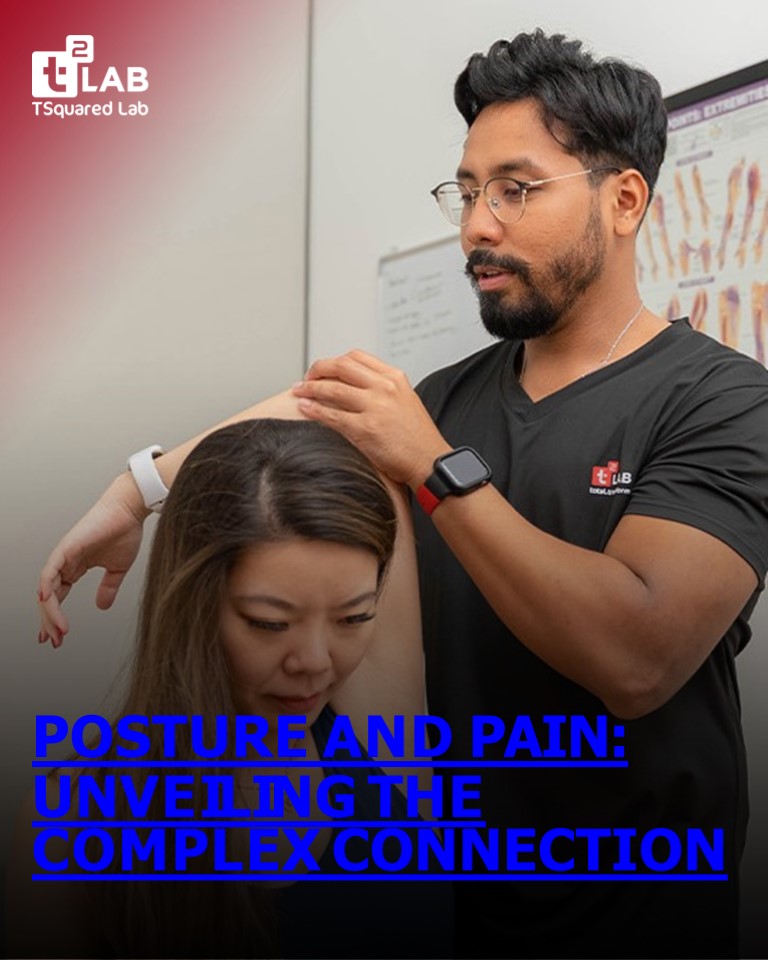Posture and Pain: Unveiling the Complex Connection PowerPoint PPT Presentation
Title: Posture and Pain: Unveiling the Complex Connection
1
POSTURE AND PAIN
UNVEILING THE COMPLEX CONNECTION
2
Posture and Pain Unveiling the Complex
Connection
- In Singapore's fast-paced environment,
maintaining good posture is a common concern. - Contrary to the belief that poor posture
directly leads to pain, there's a complex
relationship between posture and pain that
merits exploration.
3
The Myth of Simple Cause and Effect
4
The Myth of Simple Cause and Effect
- Poor posture isn't the direct cause of pain.
Instead, it's one of many factors in a complex
equation affecting physical well-being. The
relationship between posture and pain is
intricate, influenced by various elements.
5
Understanding the Factors Influencing Pain
6
Understanding the Factors Influencing Pain
- Pain is influenced by genetics, lifestyle, and
individual differences. Genetic predispositions,
lifestyle choices, and personal variations all
contribute to how our bodies respond to posture
and experience pain.
7
Posture as One of Many Contributors
8
Posture as One of Many Contributors
While posture is a factor in pain, it's not the
sole cause. A holistic view is crucial,
considering genetics, lifestyle, and individual
differences in understanding pain and well-
being.
9
The Importance of an Individualised Approach
10
The Importance of an Individualised Approach
- Each persons body is a unique composition of
genes, experiences, and lifestyle choices,
highlighting the need for a tailored and
individualised approach to both addressing pain
and improving posture.
11
The Importance of an Individualised Approach
Celebrating Uniqueness Your body is unique. A
posture or exercise that works for one might
not suit you. Embrace a plan that's tailored for
your individual needs. Factors Influencing
Individual Responses Your response to posture
changes is personal, influenced by your body
structure, past injuries, and daily activities.
12
The Importance of an Individualised Approach
The Need for Customised Solutions Avoid
one-size-fits-all solutions. Opt for customized
solutions that respect your body's individual
needs and challenges. The Role of Healthcare
Professionals Healthcare professionals are key
in your journey to better posture, offering
personalised plans based on a thorough
understanding of your unique case.
13
Postures Role in Pain Prevention
14
Postures Role in Pain Prevention
- Understanding the preventive role of good
posture is crucial. It's not the sole cause of
pain, but maintaining it helps prevent
musculoskeletal issues and promotes a healthier
life. Strive for a balanced perspective good
posture significantly contributes to overall
well-being.
15
Tips for Cultivating and Sustaining Good Posture
16
Tips for Cultivating and Sustaining Good
Posture Ergonomic Workspaces In a city where
office work is prevalent, creating an ergonomic
workspace is crucial. Adjust the height of
chairs and desks, position monitors at eye
level, and support the lower back with
appropriate chairs to encourage good
posture. Regular Breaks and Movement Encourage
breaks throughout the day, especially for those
with sedentary jobs. Simple stretches and
movements help prevent stiffness and promote
better posture.
17
Tips for Cultivating and Sustaining Good
Posture Strengthening Exercises Incorporate
exercises that target core strength, back
muscles, and flexibility. A strong and flexible
musculature provides essential support for
maintaining good posture. Mindful Posture
Check-Ins Develop a habit of regularly
checking and correcting your posture. Mindful
awareness can help break the cycle of poor
posture and instill healthier habits.
18
Tips for Cultivating and Sustaining Good
Posture Yoga and Pilates Consider integrating
practices like yoga or Pilates into your
routine. These disciplines focus on body
awareness, core strength, and flexibility all
of which contribute to improved
posture. Sleeping Posture Pay attention to
your sleeping posture. Use supportive pillows
and mattresses that align with the natural
curves of your spine.
19
The Holistic Approach to Prevention
20
The Holistic Approach to Prevention Preventing
pain goes hand in hand with adopting a holistic
approach to well-being. Cultivating good
posture is a proactive step toward maintaining a
healthy musculoskeletal system and preventing
pain-related issues. Real-life stories often
provide the most compelling evidence. Lets
delve into case studies that challenge the
long-standing stereotype of poor posture as the
primary cause of pain.
21
Case Study 1 The Active Professional Meet
Jason, a young professional immersed in
Singapores fast- paced corporate world. Despite
maintaining a seemingly ideal posture at his
desk, Jason began experiencing persistent lower
back pain. Upon closer examination, it was
revealed that his pain was exacerbated by a lack
of regular movement throughout the
day. Implementing a routine of stretching and
short walks significantly alleviated his
discomfort, emphasising the role of sedentary
behavior rather than posture as the primary
contributor.
22
Case Study 2 The Athletes Dilemma Melissa, an
avid athlete, faced recurring knee pain that
seemed unrelated to her exercise routine. While
her running form and posture appeared
impeccable, a thorough assessment revealed
muscle imbalances and weaknesses in her hip and
gluteal muscles. Targeted exercises to address
these weaknesses not only improved her posture
but also resolved the underlying cause of her
knee pain.
23
Key Takeaways from Case Studies Diverse
Contributing Factors Pain can stem from various
sources, including lifestyle, movement
patterns, and muscle imbalances. Individualised
Solutions Each case requires a tailored
approach, acknowledging the unique needs and
challenges faced by individuals. Comprehensive
Assessments Thorough assessments, often
involving healthcare professionals, are crucial
in identifying the root causes of pain.
24
Key Takeaways from Case Studies Physical
Therapy addresses more than posture, assessing
movement, muscle imbalances, and joint mobility
for lasting musculoskeletal health
improvements. Targeted Exercises tailored for
strength, flexibility, and balance address root
causes of pain and prevent future issues,
enhancing overall body function. Mindfulness and
Stress Management Mindfulness practices reduce
stress and muscle tension, promoting better
posture and contributing to overall physical
and mental well-being.
25
Visit our website
www.tsquaredlab.com
Follow us on
_at_tsquaredlab

